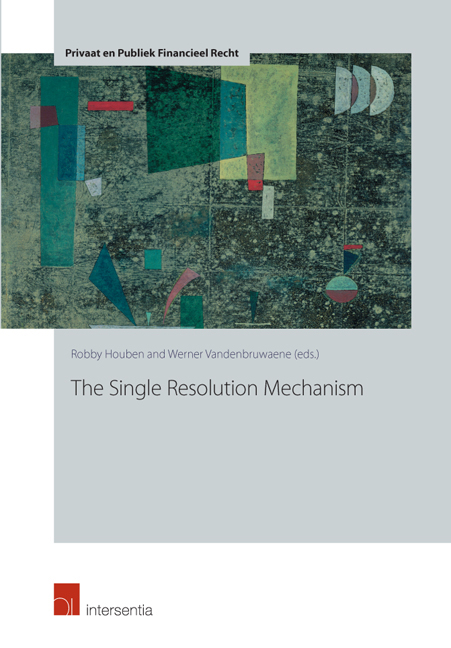Book contents
- Frontmatter
- Preface
- Contents
- Introduction: Recovery and Resolution, Future Solutions for Dealing with Insolvency
- The Single Resolution Mechanism. Institutional and Financing Arrangements for Bank Resolution in the European Banking Union
- Resolution from the Belgian Resolution Authority's Perspective
- Judicial Protection in the Single Resolution Mechanism
- The Rules on State Aid and the Framework for Bank Resolution: Foreplay and Interplay
- Concluding Remarks on Resolution and Resolvability Challenges
The Single Resolution Mechanism. Institutional and Financing Arrangements for Bank Resolution in the European Banking Union
Published online by Cambridge University Press: 25 September 2018
- Frontmatter
- Preface
- Contents
- Introduction: Recovery and Resolution, Future Solutions for Dealing with Insolvency
- The Single Resolution Mechanism. Institutional and Financing Arrangements for Bank Resolution in the European Banking Union
- Resolution from the Belgian Resolution Authority's Perspective
- Judicial Protection in the Single Resolution Mechanism
- The Rules on State Aid and the Framework for Bank Resolution: Foreplay and Interplay
- Concluding Remarks on Resolution and Resolvability Challenges
Summary
INTRODUCTION
As a reaction to both the global and European financial crises, and as a response to the fiscal crisis in the Euro Area in particular, the political leaders of the European Union initiated the idea of a “European Banking Union” (hereinafter the EBU) on 29 June 2012. The EBU consists of three distinctive pillars.
The Single Supervisory Mechanism (hereinafter the SSM) is the first pillar of the EBU. The supervisory framework for the Euro Area banking sector has been effective since November 2014. As of that date, the European Central Bank (hereinafter the ECB) has been in charge of supervising the most significant credit institutions in the Euro Area, comprising a total of 85% of the total balance sheet assets of Eurozone banks. The mechanism is characterised by a division of tasks, an exchange of information and close cooperation between the ECB and the National Competent Authorities (hereinafter the NCAs) who remain the competent supervisors for the other, and hence “less significant”, credit institutions.
The Single Resolution Mechanism (hereinafter the SRM) is the second pillar of the EBU. The SRM Regulation entered into force on 19 August 2014, and is directly applicable in all Member States from 1 January 2016 onward. Like the framework under the SSM, it sets out a mechanism for the resolution of unviable credit institutions, characterised by the key relationship between a central decision maker created at a Euro Area level, i.e. the Single Resolution Board (hereinafter the SRB), and the national authorities who still have a vital role to play. Furthermore, the creation of a Single Resolution Fund (hereinafter the SRF) is to be discussed in the context of the SRM. Both the institutional set-up and the financing arrangements within the SRM are the main topics of this contribution.
As both the SSM and SRM comprise “mechanisms”, there is of course a great deal of similarities between both structures, given that they operate within the same jurisdictional and institutional parameters and rely upon an extensive centralisation of executive powers. The mechanisms thus have both supranational and intergovernmental features. However, there is also a great deal of differences between the two mechanisms. The SRB is an EU agency and not an EU treaty institution, like the ECB.
- Type
- Chapter
- Information
- The Single Resolution Mechanism , pp. 7 - 48Publisher: IntersentiaPrint publication year: 2017

